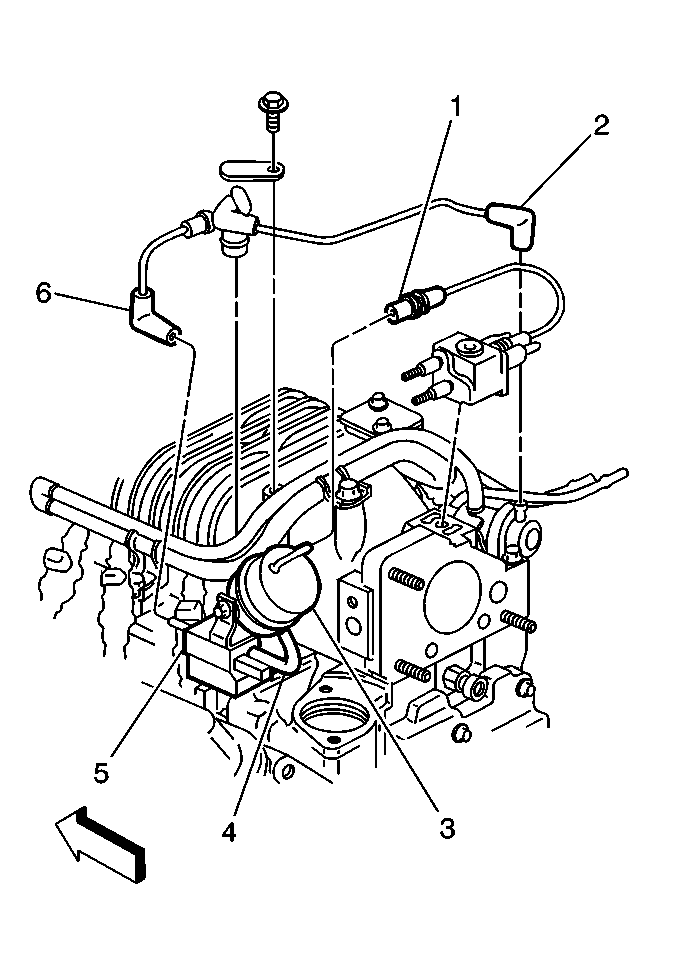

| (1) | Vacuum Signal to Bypass Valve Actuator |
| (2) | Boost Signal to Fuel Pressure Regulator |
| (3) | Bypass Valve Actuator |
| (4) | Boost Signal to Bypass Valve Actuator |
| (5) | Boost Control Solenoid |
| (6) | Boost Source to Boost Control Solenoid |
Circuit Description
Under most conditions, the PCM commands the boost control solenoid to operate at a 100% duty cycle (ON) to allow full boost pressure upon demand. However, if reverse gear is selected or the PCM detects rapid deceleration or engine load is extremely high, reduced boost pressure is desired. Under these conditions, the PCM commands the boost control solenoid to operate at a 0% duty cycle (OFF), which opens the bypass valve. With the Bypass valve open, boost pressure is reduced by recirculating intake air back through the supercharger inlet.
Diagnostic Aids
If the Boost Control System Check has been performed and no electrical or vacuum related fault is noted, check for the following conditions:
| • | Misadjusted or sticking Bypass Valve Actuator. Refer to Supercharger Bypass Valve Actuator |
| • | Binding Bypass Valve or Bypass Valve linkage. Refer to Supercharger Section 6G. |
An intermittent may be caused by a poor connection, rubbed through wire insulation, or a wire broken inside the insulation. Check for the following conditions:
| • | Poor Connection or Damaged Harness - Inspect PCM harness connector for backed out terminals, improper mating, improperly formed or damaged terminals, poor terminal to wire connection and damaged harness. |
| • | Intermittent Test - Disconnect the PCM and install a digital multimeter to monitor voltage between the Boost Control Solenoid control circuit at the PCM connector and ground. Observe the voltage while manipulating related connectors and wiring harness with the ignition switch ON. If the failure is induced, the voltage display will change. This may indicate the location of the fault |
Test Description
Number(s) below refer to the step number(s) on the Diagnostic Table.
-
Verifies ignition feed to the boost control solenoid.
-
The boost control solenoid should be commanded OFF (0% duty cycle) with the ignition ON, engine not running. If the system is functioning properly, the test light should be OFF.
-
Ensures that the PCM can control the ODM output for the Boost Control Solenoid and the Boost Control Solenoid control circuit is not open.
-
Checks for a malfunctioning Boost Control Solenoid (sticking open or leaking).
-
This vehicle is equipped with a PCM which utilizes an Electrically Erasable Programmable Read Only Memory (EEPROM). When the PCM is being replaced, the new PCM must be programmed.
Step | Action | Value(s) | Yes | No | |||||||||||||
|---|---|---|---|---|---|---|---|---|---|---|---|---|---|---|---|---|---|
1 | Was the On-Board Diagnostic (OBD) System Check performed? | -- | |||||||||||||||
Is the test light ON? | -- | ||||||||||||||||
Connect the test light between the Boost Control Solenoid harness connector terminals. Is the test light ON? | -- | ||||||||||||||||
Is the test light ON when the Boost Control Solenoid output is commanded ON? | -- | ||||||||||||||||
Does the vacuum gauge indicate near the specified value? | 0 in. Hg | ||||||||||||||||
6 |
Does the vacuum gauge indicate greater than the specified value with the Boost Control Solenoid turned OFF? | 15 in. Hg | |||||||||||||||
7 |
Was a problem found? | -- | |||||||||||||||
8 |
Does the vacuum gauge indicate greater than the specified value? | 15 in. Hg | Refer to Diagnostic Aids | ||||||||||||||
9 | Repair the restriction
in the inlet vacuum signal hose to the Bypass Valve Actuator or blocked inlet
vacuum source. Refer to
Is action complete? | -- | -- | ||||||||||||||
10 |
Was a problem found? | -- | |||||||||||||||
11 | Check the fuse for the Boost Control Solenoid ignition feed circuit. Is the fuse blown? | -- | |||||||||||||||
12 | Locate and repair short to ground in the ignition feed circuit. Refer to Repair Procedures in Electrical Diagnosis. Is action complete? | -- | -- | ||||||||||||||
13 | Locate and repair open in the ignition feed circuit to the Boost Control Solenoid. Refer to Repair Procedures in Electrical Diagnosis. Is action complete? | -- | -- | ||||||||||||||
14 |
Is the test light ON? | -- | |||||||||||||||
15 | Locate and repair short to ground in the Boost Control Solenoid control circuit. Refer to Repair Procedures in Electrical Diagnosis. Is action complete? | -- | -- | ||||||||||||||
16 |
Was a problem found? | -- | |||||||||||||||
17 |
Was a problem found? | -- | |||||||||||||||
18 | Replace the Boost Control Solenoid. Refer to Boost Control Solenoid . Is action complete? | -- | -- | ||||||||||||||
19 |
Was a problem found? | -- | |||||||||||||||
Replace the PCM. Important: The replacement PCM must be programmed. Refer to Powertrain Control Module Replacement/Programming . Is action complete? | -- | -- | |||||||||||||||
21 |
Does the MAP value decrease while the boost sol. is commanded ON and increase while the boost sol. is commanded OFF? | -- | |||||||||||||||
22 | Reconnect the inlet
vacuum signal line to the bypass valve actuator. Refer to
Is action complete? | -- | System OK | -- |
